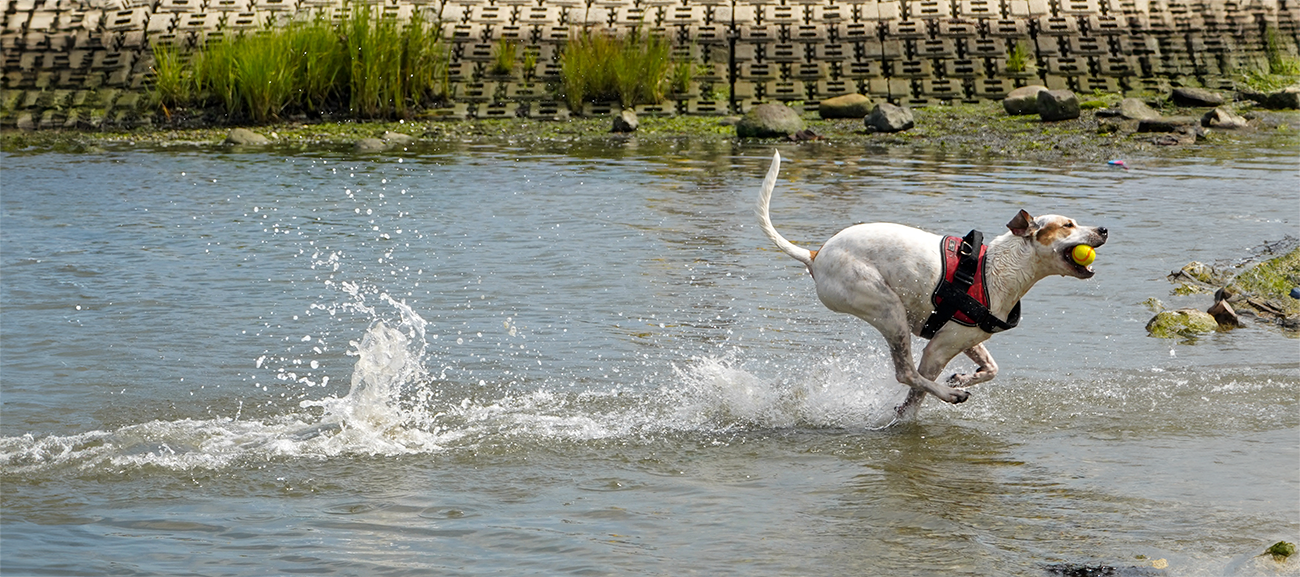LEPTOSPIROSIS
The Lepto vaccine has recently been shifted from non-core to essential core vaccine status recommendation for dogs in the United States.
This really warrants us looking at this disease, at the vaccination, and making the decision if this is right for your situation and your dog.
It is a disease caused by a spirochete, a corkscrew shaped bacteria that is picked up from drinking stagnant water or from streams frequented by wildlife. It is shed from the urine of rats, raccoons, foxes, skunks, and cows. In big cities where rats are common, Lepto can be picked up off sidewalks or crevices where rat urine can collect. Hot humid weather will improve the odds of transmission. The bacteria penetrate into the kidneys and liver of the dog causing significant fever and illness that elevates both kidney and liver values; the bacteria can then in turn be shed into the urine of the dog and infect the human cleaning this up. The mortality rate for this disease is about 20%. There are at least seven subtypes of leptospirosis that can infect the dog.
What about vaccination?
The current vaccines protect against four of the seven subtypes. The vaccine is also a bacterin vaccine, meaning that it is composed of a filtered mix of bacterial components from the four subtypes of Lepto. The immunity will not be as long lived as the Rabies vaccine, which is adjuvanted (another component added to stimulate sufficient immunity), or the Distemper/Parvo vaccine which is a modified live virus that replicates but can’t cause disease. And so for this disease the recommendation is to vaccinate annually although the known DOI (Duration of Immunity) on most of these preparations is 15 months.
Do we give this vaccine?
It does have four subtypes of the Lepto mixed into the vaccine and presents the whole bacteria to the immune system. It is difficult although possible to filter out other proteins but this accounts for this vaccine having the highest reaction rate along with this shorter known duration of immunity.
Look at the risk factors for your dog. High risk includes hunting dogs, dogs that go camping or hiking in wilderness areas with their owners, and dogs that live in cities with high rat populations. Look at the prevalence in your area. The number of human cases annually in the United States is 100 to 250. The number of cases in dogs is unknown but this is not a commonly diagnosed disease. This central New Jersey practice has had three documented cases over twelve years. The triggers that would make your veterinarian look for this are fever, elevated kidney and liver values, and bloody urine.
If you decide, after having this information, that you would feel best having the protection of this vaccine, then consider separating it from any other vaccination by at least two months. So consider waiting two months from the first Rabies vaccine to give the first Lepto vaccine. Give the second booster one month later as indicated. Then consider keeping track of and administering the vaccine every 14 to 15 months after that because that is the known Duration of Immunity of this vaccine and will keep it separate from other vaccinations. We cannot measure memory cell immunity and so do not know how long this vaccine can generate a faster immune response on exposure, but the known length of time is 15 months. This will not be what is advised by your veterinarian since the standard is the annual reminder. If you forgo this vaccination then consider leashing your dog or keeping them close when near water on your hikes, and carrying fresh water and a container for them to drink from offered periodically during the hike.
This is a decision only you can make based on risk and how much vaccination your dog can handle. It should not be considered routine. It is a reactive vaccine that must be given with frequent boosters to a disease that exists in our environment and is potentially zoonotic but is not common.
LYME VACCINATION
Should you vaccinate your dog against Lyme disease? First, we have to know a bit about the disease itself in dogs.
This is another spirochete bacteria, this time introduced into the dog via a tick bite. Commonly a deer tick that has been on a field mouse or deer tick climbs onto the dog on a walk by high brush or under a bush. The spirochete bacteria sheds its attachment to the tick intestine and slides into the bloodstream of the dog immediately expressing other antigens in its new home.
About 95% of infected dogs will never show any symptoms. Of those that do, the symptoms are from the immune reaction to the organism: the antigen antibody complex that is deposited in or caught up in the joints or kidneys. In dogs that show symptoms this phase of the disease appears as mild fever with joint pain, lameness, and reluctance to move. This phase is often transient, and recovery occurs with or without treatment. In a very small percentage of dogs the immune response is so violent it damages the kidneys, which is called Lyme nephropathy. It is possible that vaccination for Lyme could actually make the odds of this worse by heightening the immune response to a disease that is already caused by an excessive immune response.
Lyme is of course not the only disease that ticks can give dogs; the list is quite long.
Given this information does it still make sense to vaccinate for this disease? Prevention surely must come from tick control rather than hypersensitizing the immune system to a disease that causes very little illness in the vast majority of dogs.
INFLUENZA VACCINATION
Currently the Flu vaccine for dogs protects against two strains of Influenza virus that have been diagnosed in dogs.
The vast majority of dogs exposed to these viruses do not get sick. A very small percentage of dogs will develop an upper respiratory infection that deepens into pneumonia.
Flu outbreaks are not common and very difficult to diagnose because the only dogs seen at the veterinary hospital present with coughing and pneumonia that is seldom traced back to this virus.
It is labelled for annual revaccination so after that initial series of two boosters a month apart the dog must return annually and have this vaccine over and over again to stay “current”. It would make sense to prevent this disease by avoiding high stress crowded boarding facilities in favor of in-home dog walkers or small facilities with low stress and just a few dogs.
If your daycare or boarding facility requires this vaccination it may be time to reconsider that option for your dog.
BORDETELLA
Kennel cough is often presented as an emergency, even in the middle of the night, because the cough is so loud and choking. The cough is from tracheobronchitis: inflammation of the trachea and bronchii. This disease is alarming but not lethal and generally runs its course in 3 to 5 days with or without treatment.
There are three forms of vaccination: injectable, intranasal, and intra-buccal meaning into the cheek pouch. None of these are very effective, but the intra-buccal is the best tolerated and gives the best chance of generating enough local immunity to slow the disease down in the spot where it arrives in the body. This vaccine is at best 70% effective and the immunity does not last very long. It is acceptable and wise to give this vaccine about two weeks before boarding but it will not necessarily prevent illness.
Rarely but possible, the kennel cough vaccine itself can cause symptoms of kennel cough and cause shedding of the kennel cough organism because it is a modified live vaccine. Be mindful of this in the week or two after the vaccine is given.
Really step back and consider each of these vaccines for their ability to protect your dog against a real threat balanced against the risk of the effect of these on the immune system especially given repeatedly and together over time. Caution is warranted.

